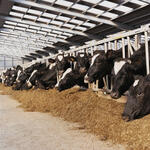- Date: 13 April 2022
- Author: Julia Kurnik and Katherine Devine, World Wildlife Fund
Most agricultural methane emissions (around 70%) come from ruminants, such as cows and sheep. This is primarily due to manure and gastroenteric releases—or, simply put, cow burps. Most methane for cattle, particularly beef, is released in the grazing phase of the supply chain. When cattle roam for grazing, it is difficult to track methane release or to mitigate emissions due to the nature of grazing. Furthermore, scalability and traceability are challenging, particularly for small-scale grazing operations.
- Date: 12 April 2022
- Author: By Julia Kurnik and Katherine Devine, World Wildlife Fund
Rice, one of the most abundant crops grown and consumed globally, makes up 12% of global methane emissions – and a staggering 1.5% of total greenhouse gas emissions. When rice is harvested, a ton of rice stubble and straw is left behind for every ton of harvested rice – 750 million tons globally in 2015. Currently, to clear fields for future crops, farmers either burn the rice straw, which results in significant carbon dioxide emissions as well as methane, carbon monoxide, nitrogen oxides, sulfur oxides, and particulate matters, or they flood the field to encourage swift decay – which also leads to extensive methane emissions.
- Date: 11 April 2022
- Author: Julia Kurnik and Katherine Devine, World Wildlife Fund
Global leaders in Glasgow recently signed the Global Methane Pledge and recognized that addressing methane emissions is imperative if we’re going to achieve a 1.5° C future. In fact, the IPCC calculates that methane emissions will need to drop 37% below 2017 levels by 2030 and 55% below 2017 levels by 2050 to keep that goal within range. At COP 26, President Biden announced the US will join a global coalition of more than 100 countries pledging to cut global methane levels by a minimum of 30% by 2030 and rolled out an action plan for US methane emissions reductions.
- Date: 03 February 2022
- Author: Julia Kurnik, Director of Innovation Startups, WWF Markets Institute
To most people, the United States Postal Service (USPS) is a low-cost way to send a letter, but here at the Markets Institute, we believe it has the potential to deliver more than just mail.
In spring 2020, people stayed at home and cooked more, grocery store shelves were bare, and farmers serving commercial food businesses were stuck leaving healthy food to rot in fields. And this was all happening as food insecurity skyrocketed. These problems weren’t new, but exacerbated, so we began to rethink how we get healthy produce to people. This sparked conversations with farmers, food hubs, the USPS, USPS unions, elected officials, hunger relief groups, and others, a business case, and popular interest. The result? An idea for “Farmers Post,” a third-party led platform to allow farmers to ship produce directly to consumers via the USPS, improving market access for small and minority farmers while simultaneously expanding access to healthy, fresh, local produce for consumers across the US.
- Date: 23 November 2021
- Author: Alex Nichols-Vinueza, Program Manager, Food Loss and Waste
For most of us, Thanksgiving is all about the food. And for those looking to have a more environmentally-friendly Thanksgiving this year, the number one thing we can do is take steps to value the food we’re serving. This starts with us recognizing all of the resources that go into producing our Thanksgiving meal (long before we purchase our ingredients at the supermarket), and it ends with us doing our part to make sure none of it goes to waste.




